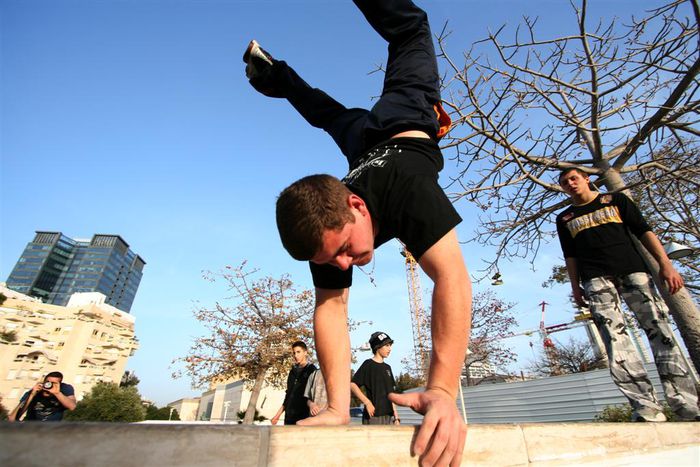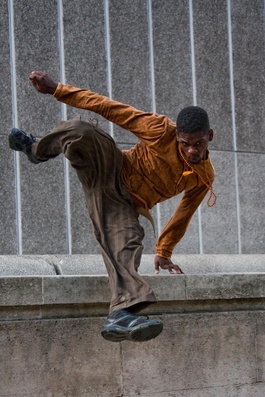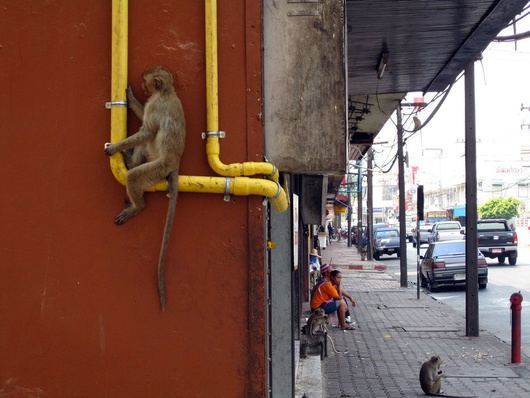
From Bergamo to Laos: parkour with Gato, Italian traceur
Published on
Translation by:
Jude ListerFederico, or 'Gato' ('Cat') as he likes to be known, is an Italian biologist. But his real passion is for parkour - or rather the art of moving, a discipline which allows man to discover his own body and its limits
Federico, aka 'Gato', is writing to me from Laos - one of the destinations on his trail across South-East Asia. His companions in this adventure are a meticulously-prepared survival kit and his own physique. The body, he explains, 'is the only instrument and only protection that we have.' Gato is a biologist by profession, and a traceur (parkour practitioner) at heart: he tests himself within different spaces (urban centres and outskirts, the countryside, and now also jungles). He discovered the discipline five years ago at the age of twenty, and he says that the effect was like 'a mental explosion.'
The art of movement
 Parkour is by definition 'the art of mastering movement': knowing your own body and its limits in order to then expand its capacities, learning how to move fluidly, and finding your 'inner animal'. To start with the budget required is minimal: a pair of running shoes (even if the most audacious challenge themselves by practising barefoot) and a defined space. Parkour was born in the outskirts of cities, but you can trace your own path anywhere, according to your tastes and above all the circumstances – variables which the traceur can exploit to diversify his or her moves, possibly without ever repeating the same sequence.
Parkour is by definition 'the art of mastering movement': knowing your own body and its limits in order to then expand its capacities, learning how to move fluidly, and finding your 'inner animal'. To start with the budget required is minimal: a pair of running shoes (even if the most audacious challenge themselves by practising barefoot) and a defined space. Parkour was born in the outskirts of cities, but you can trace your own path anywhere, according to your tastes and above all the circumstances – variables which the traceur can exploit to diversify his or her moves, possibly without ever repeating the same sequence.
The effort necessary is more costly: conditioning exercises, Hérbert’s natural method, pure technical sessions... Strengthening one’s physique is essential, but without indulging too much in the hedonism of the gym culture. The objective is always to move around within real, concrete situations, whether they are spontaneous or sought out. Parkour is the ideal sport for those who, like Gato, feel themselves to be born explorers and test drivers. There are no predetermined rules, improvisation is a must because spaces change and in turn confront the traceur. In urban environments, knowing how to move fluidly makes Gato feel more secure, freer in every situation.
To each their own trajectory
Regardless of the ethics of the discipline’s pioneers, each has their own way of practising. Gato is in no doubt about how to make parkour an outlet for self-expression. 'I’m looking for another way to experience things, reclaiming my right to be responsible for my own actions, to live in my environment in my own personal way. I’m affirming my right to improve myself as much as I can.' When I prod him about the element of exhibitionism, he simply says that he doesn’t want people to focus on his acrobatics, but for them to find ideas which help them interact with their environments in new ways and follow their own trajectories within these spaces. This is why he’s not a big fan of the international competitions, which the founders of parkour have never officially recognised.
'I’m reclaiming my right to live in my environment in my own way'
For Gato, free running meetings are macho competitions designed only to crown the dominant leaders. Even if as an evolutionary biologist he accepts competitiveness, he doesn’t like it when the art is turned into a spectacle. He prefers to value his movements on the basis of utility, like those of animals: prey fleeing a predator or the search for the shortest migration route, for example. Beauty comes after - first you must learn how to fall, cushion knocks and blows, and grip onto different surfaces.
Looking for alternative ways
 There are parkour courses - or to be more exact, 'laboratories' - touring the world, but Gato is sceptical about their validity. Parkour involves working on your own resistance, not only physically but also mentally. You have to seek out alternative ways, perhaps observing the movements of animals. Gato recently tried to imitate a mole by walking on semi-flooded pathways on all fours. Eclecticism is another inescapable resource for this sport which has neither a points system nor defined tracks, bearing in mind that all living beings across the ages and under all conditions have needed to move around. In Italy the parkour scene is a little stagnant, perhaps due to mistrust, or because of the 'football fever' which leaves little space for other sports.
There are parkour courses - or to be more exact, 'laboratories' - touring the world, but Gato is sceptical about their validity. Parkour involves working on your own resistance, not only physically but also mentally. You have to seek out alternative ways, perhaps observing the movements of animals. Gato recently tried to imitate a mole by walking on semi-flooded pathways on all fours. Eclecticism is another inescapable resource for this sport which has neither a points system nor defined tracks, bearing in mind that all living beings across the ages and under all conditions have needed to move around. In Italy the parkour scene is a little stagnant, perhaps due to mistrust, or because of the 'football fever' which leaves little space for other sports.
It is livelier in Scandinavian countries, where Gato has been able to meet traceurs coming from all over Europe. On his travels, he always tries to contact local traceurs, those who know well the spaces through which he will have to navigate: in Bangkok he already has a contact who will help him study how to move. Information is usually exchanged through internet forums and via email. Finding out which kind of surfaces you have to deal with, imagining the type of moves you can make, but above all feeling prepared for your body to communicate with the environment. Gato may not have nine lives, but he does have sufficient curiosity to choose his own routes to follow, claws ready to grip or defend himself, and a versatile metabolism which gives energy in just the right doses. In short, he’s well-equipped to move around in this life, and is sure to always land firmly on his feet.
Images: ©LexnGer; ©JB London; ©gkamin; ©Federico gato Mazzoleni; courtesy of Flickr/Video from Youtube byfetztheca
Translated from L'agilità dell'uomo-gatto: parkour, l'arte dello spostamento



